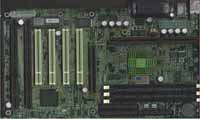Supermicro P6SBA BX Pentium II Board
by Anand Lal Shimpi on April 20, 1998 12:49 PM EST- Posted in
- Motherboards
Anand Tech Report Card Rating 94/A-
| CPU Interface | Slot-1 |
| Chipset | Intel 440BX |
| L2 Cache | N/A (on-chip) |
| Form Factor | ATX |
| Bus Speeds | 66/100 MHz |
| Clock Multipliers | 2.0x - 6.0x |
| Voltages Supported | 1.3v - 3.5v (Auto-Detect) |
| Memory Slots | 3 168pin DIMM Slots (EDO/SDRAM) |
| Expansion Slots | 1 AGP Slot 4 PCI Slots 3 ISA Slots (1 Shared / 3 Full Length) |
| BIOS | AMI WinBIOS |
We've heard this time and time again in the BX world, 4 PCI, 3 ISA, and 1 AGP slot, nothing more to it. If you have more than 4 PCI cards you may want to shift your attention to the MTech/Soyo BX board, if you need more than 3 ISA slots you may want to search for upgrades to some of your older peripherals as it is highly unlikely that you will see that happening. The three DIMM slots on the P6SBA should be more than enough for average users, an extra DIMM slot wouldn't hurt of course.
| The P6SBA's layout is common to more than one motherboard, it is much like that of the ASUS P2B and the DFI P2XBL, however the P6SBA's jumper setup is a bit easier to configure. A single jumper controls the bus speed, off for 100MHz, on for 66MHz. The clock multiplier is controlled by a standard 8-pin jumper block located out of the way of any obstructions, aided by the comprehensive Supermicro manual you shouldn't have too much trouble setting this board up. |  |
Unlike most motherboards, Supermicro chose to go with the AMI WinBIOS instead of the Award PnP BIOS for their CMOS Setup Utility. The AMI WinBIOS mimics the old Windows 3.11 interface and even allows you to navigate through the setup with your mouse provided it is plugged in at the time of startup. While this is a "cute" feature, the WinBIOS does not lack in power when compared to the more conventional Award BIOS. In fact, the AMI WinBIOS can be a very difficult setup to configure, especially when dealing with the Chipset Features and Memory Timings. Luckily, like most other BX motherboards, the P6SBA offers a SDRAM Auto configuration setting which communicates with your PC100 SDRAM using its on-board SPD ROM (those extra bucks spent on SDRAM w/ on-board EEPROM finally pay off) that configures your Memory for the best possible combination of stability/performance, virtually eliminating the need to learn the meanings of all of your BIOS Settings.
If you do feel like manually configuring your SDRAM is necessary, the Supermicro User's Manual also doubles as an AMI WinBIOS manual, and a very good one at that. Not only does the manual provide the best explanation this webmaster has seen of common BIOS settings, but it also recommends what settings should be enabled/disabled (unfortunately quite a few settings are left with the phrase "leave as default setting" next to them).
The stability of the P6SBA isn't something you can complain about, the motherboard is solid as a rock and it is obvious that the board was intended to be run in a do-or-die situation like its Dual Processor Brothers, the P6DBS and P6DBE.
The performance of the P6SBA is identical to that of the P6DBS and P6DBE when using a single processor, in comparison, the Supermicro board falls in-between the top two performers in the BX World currently, the ABIT BX6 and the Top Tier performing ASUS P2B. Congrats to Supermicro on another job well done, however you overclockers out there may be a little more than disappointed with one of the P6SBA's "features..."
| Don't plan on overclocking the P6SBA, if you have a Pentium II - 233, 266, 300, or 333 (66MHz bus speed Pentium II's) then the P6SBA will auto-detect the proper bus speed for your CPU and it will clock your system accordingly. You could set your system to 100 x 3.5, and the board would still over-ride your decision by clocking it at 66 x 3.5. Of course, as with other BX motherboards, the Pentium II - 350 and 400 can only be clocked at their rated speeds (350MHz & 400MHz respectively) regardless of the clock multiplier used. If you want the performance of a Pentium II - 400 on this motherboard then you're going to have to buy a Pentium II - 400 to get it. |  |
That's the only real beef you may have with the P6SBA, the "one-size fits all" user's manual that also contains the P6DBS, DBE, and SBS' jumper settings may make you a bit un-easy however rest assured that it is a very thorough manual.










0 Comments
View All Comments